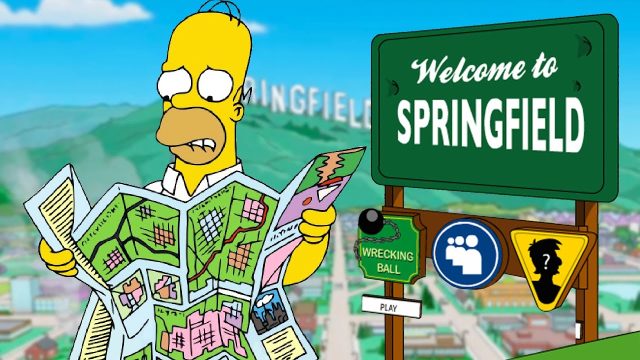The other day, in a deeply weird celebration of the birth of Charles Schulz, Beetle Bailey ran a strip wherein Beetle was camped by a stream and Snoopy was floating away to his doom. I mentioned this to our own Anthony Pizzo, and he asked me where the strip is set. The answer, of course, is “Camp Swampy.” But where Camp Swampy is, that’s a different question. One which has no answer. You can make guesses, based on internal clues, but it has never been established for sure. The best you can do is “Camp Swampy, USA.”
This is a fascinating and common phenomenon. Matt Groening recently said that Springfield is actually Springfield, Oregon, but of course it’s not. It may have been when the show started, but the real Springfield, Oregon, bears less and less resemblance to its fictional counterpart. Maybe if they’d called it Springfield, Oregon, from the outset, they would’ve kept its similarities in place, but by setting in in Fictional State, they were able to put everything in the town and surrounding area that they need. Surely this is one of the reasons to never quite establish what state you’re in.
My son and I have been reading Encyclopedia Brown together over the last few months, one story a night at bedtime, with him trying to solve the mystery. And the mystery we’ve long wondered about is the mystery of where, exactly, Idaville is. We’ve pieced together enough evidence to believe it’s Florida—for one thing, a character in last night’s story was visiting family in Tallahassee—but it’s never made explicit in the books. Idaville is expressly established in the first story of every book to be just like any small American town, provided it’s a small American town on the seaside.
Often, it seems likely that the decision to leave the state unmentioned is to let the audience connect with it regardless of where they live. That’s Groening’s stated motivation—he says people over the years from Springfields across the US have asked him if it’s their own state’s Springfield, and he always says yes, because why not? That’s probably the case with Idaville and Camp Swampy and innumerable others as well. You can believe wherever-it-is is local, because in theory that makes you feel more connected.
Sometimes, though, as with Springfield-as-it-is-now, it gives you the freedom to play with whatever you need. The geology and climate of the Simpsons’ hometown has allowed for a wide array of stories, with hurricanes and volcanoes both featuring. Flanders apparently says in the movie that it’s bordered by Ohio, Maine, Kentucky, and Nevada, and allegedly it has a desert three times the size of Texas. We can be pretty sure it’s not in Alaska, because the aurora borealis are less surprising in Alaska, but that’s one of the only things we have any certainty on.
Stephen King has made a cottage industry—and a highly successful one—out of playing around with the geography of Maine, and that’s fine. Castle Rock is in Maine and always has been. On the other hand, however, that limits him to known features of Maine. He can’t have the Castle Rock badlands, just lakes and forests. What’s more, people who know Maine will always complain about what he gets wrong; a friend of mine from there insists that no one actually says “ayup,” for example. The fictional state allows for a certain freedom as well as the possibility of the universal.
Buy my kids a Krusty Burger by supporting my Patreon or Ko-fi!


